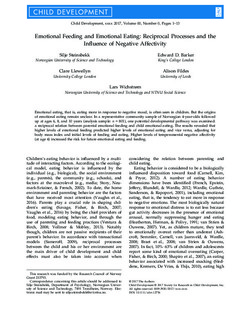| dc.contributor.author | Steinsbekk, Silje | |
| dc.contributor.author | Barker, Edward D. | |
| dc.contributor.author | Llewellyn, Clare | |
| dc.contributor.author | Fildes, Alison | |
| dc.contributor.author | Wichstrøm, Lars | |
| dc.date.accessioned | 2017-12-11T08:11:27Z | |
| dc.date.available | 2017-12-11T08:11:27Z | |
| dc.date.created | 2017-04-26T14:59:33Z | |
| dc.date.issued | 2017 | |
| dc.identifier.issn | 0009-3920 | |
| dc.identifier.uri | http://hdl.handle.net/11250/2469866 | |
| dc.description.abstract | Emotional eating, that is, eating more in response to negative mood, is often seen in children. But the origins of emotional eating remain unclear. In a representative community sample of Norwegian 4-year-olds followed up at ages 6, 8, and 10 years (analysis sample: n = 801), one potential developmental pathway was examined: a reciprocal relation between parental emotional feeding and child emotional eating. The results revealed that higher levels of emotional feeding predicted higher levels of emotional eating and vice versa, adjusting for body mass index and initial levels of feeding and eating. Higher levels of temperamental negative affectivity (at age 4) increased the risk for future emotional eating and feeding. | nb_NO |
| dc.language.iso | eng | nb_NO |
| dc.publisher | Wiley | nb_NO |
| dc.title | Emotional Feeding and Emotional Eating: Reciprocal Processes and the Influence of Negative Affectivity | nb_NO |
| dc.type | Journal article | nb_NO |
| dc.type | Peer reviewed | nb_NO |
| dc.description.version | publishedVersion | nb_NO |
| dc.source.journal | Child Development | nb_NO |
| dc.identifier.doi | 10.1111/cdev.12756 | |
| dc.identifier.cristin | 1466735 | |
| dc.relation.project | Norges forskningsråd: 213793 | nb_NO |
| dc.relation.project | Norges forskningsråd: 228685 | nb_NO |
| dc.description.localcode | © 2017 The Authors. Published by Wiley and the Society for Research in Child Development. | nb_NO |
| cristin.unitcode | 194,67,40,0 | |
| cristin.unitname | Institutt for psykologi | |
| cristin.ispublished | true | |
| cristin.fulltext | original | |
| cristin.qualitycode | 2 | |
